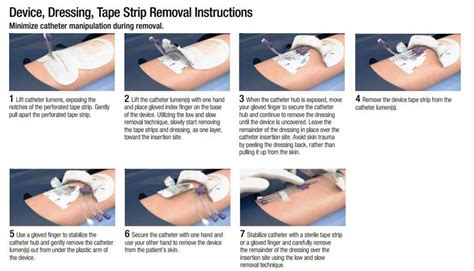How To Document Picc Line Removal
Ronan Farrow
Mar 31, 2025 · 3 min read

Table of Contents
How to Document PICC Line Removal: A Comprehensive Guide for Nurses
Removing a Peripherally Inserted Central Catheter (PICC) line requires meticulous care and precise documentation. This guide provides a step-by-step approach to ensure thorough and accurate charting, minimizing the risk of errors and complications. Accurate documentation is crucial for patient safety and legal protection.
Pre-Removal Assessment: What to Document Beforehand
Before initiating the PICC line removal process, a thorough assessment is crucial and should be meticulously documented. This includes:
Patient Identification and Verification:
- Patient's full name and date of birth: Verify against the patient's identification band and medical record. Double-checking is paramount to avoid medical errors.
- PICC line location: Note the specific vein where the catheter is inserted (e.g., basilic, cephalic).
- PICC line insertion date: Record the date the PICC line was originally placed.
- Any allergies: Document any known allergies, especially to adhesives or antiseptic solutions.
PICC Line Status and Assessment:
- Appearance of the insertion site: Describe the site's condition, noting any signs of infection (redness, swelling, drainage), inflammation, or bleeding.
- Securement device: Document the type of securement device used and its condition.
- Dressings: Note the type of dressing and its condition.
- Recent blood draws or medication administration: Record any recent procedures performed through the PICC line.
- Patient's vital signs: Record the patient's temperature, pulse, respiration, and blood pressure before removal.
During PICC Line Removal: What to Note
During the PICC line removal, precise documentation is essential. Every step should be clearly recorded.
The Procedure Itself:
- Time of removal: Precisely record the time the removal procedure began and ended.
- Technique used: Describe the method used to remove the PICC line (e.g., slow withdrawal).
- Personnel involved: List the names of all healthcare professionals who participated in the removal.
- Patient's response: Note the patient's comfort level and any signs of discomfort or pain during the procedure. Pain management techniques utilized should be documented.
- Observations during removal: Record any observations made during the withdrawal of the catheter, including the ease of removal, or any resistance encountered.
Post-Removal Assessment:
- Assessment of the insertion site: Describe the appearance of the insertion site immediately after removal (e.g., bleeding, swelling).
- Application of dressing: Describe the type of dressing applied and any instructions given to the patient regarding care of the insertion site.
- Patient education: Document the education provided to the patient regarding post-removal care and signs of complications (e.g., infection, bleeding).
- Any complications encountered: Thoroughly document any complications that arose during or after the removal procedure (e.g., bleeding, hematoma formation, or infection).
Post-Removal Follow-Up: What to Document Later
Following PICC line removal, continued monitoring and documentation are crucial.
- Follow-up assessments: Document subsequent assessments of the insertion site, noting any changes in appearance or signs of complications.
- Patient response to treatment: Record the patient's response to any treatment administered to manage post-removal complications.
- Discharge instructions: Document the discharge instructions provided to the patient, emphasizing potential complications and the need for follow-up care.
Key Considerations for Accurate Documentation
- Use precise and concise language: Avoid vague terms or medical jargon that might be misinterpreted.
- Maintain chronological order: Document events in the order they occurred.
- Use approved abbreviations: Use only those abbreviations that are recognized within your healthcare facility.
- Ensure legibility: Write clearly and legibly. If using electronic documentation, ensure proper formatting and avoid errors.
- Sign and date all entries: All entries should be signed and dated by the healthcare professional who performed the procedure.
By meticulously documenting each step of the PICC line removal process, healthcare professionals can ensure patient safety, maintain accurate medical records, and protect themselves legally. Remember, thorough documentation is a cornerstone of quality patient care.
Featured Posts
Also read the following articles
| Article Title | Date |
|---|---|
| How To Get Your Motorcycle License In Iowa | Mar 31, 2025 |
| How To Control Humidity In A Incubator | Mar 31, 2025 |
| How To Get Real Estate Clients Without Cold Calling | Mar 31, 2025 |
| How To Decorate A Round Mirror For Christmas | Mar 31, 2025 |
| How To Date Ka Bar Knives | Mar 31, 2025 |
Latest Posts
-
How High Should Transmission Temp Be
Apr 04, 2025
-
How High Should Cabinets Be Above Washer And Dryer
Apr 04, 2025
-
How High Should A Roof Be Over A Grill
Apr 04, 2025
-
How High Can Wolf Spiders Jump
Apr 04, 2025
-
How High Can Kites Fly
Apr 04, 2025
Thank you for visiting our website which covers about How To Document Picc Line Removal . We hope the information provided has been useful to you. Feel free to contact us if you have any questions or need further assistance. See you next time and don't miss to bookmark.
